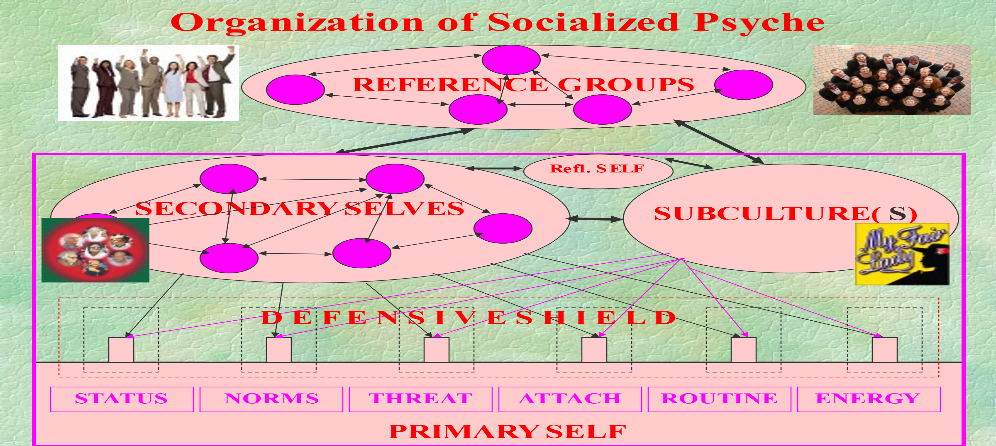Conversation 26: The decisive importance of the internalized "secondary self" which we called "subculture"
Greetings
Let's first recall the "social ego" model shown in the figure below:

First we note that the social self is mainly influenced by the external reference groups [in external reality] and even projects onto them what is reflected in the figure above. It was also said first that a structure is defined as a mental structure that expresses a defined function or functions, while external groups are defined as a group of people in external reality who have some common denominator and mutual interactions.
Below are definitions of the structures and concepts that appear in the above suggested model.
In this model we propose that one must first differentiate between the primary self [PRIMARY SELF] which is actually the basic biological core consisting of several innate structures and which is subject to development during life. and the social self [SECONDARY SELF] which is a structure that develops during the exposure of a person to social influence and consists of internalizations of figures significant to a person that originate either from external groups or from imaginary groups related for example to a character from a myth, from a movie, and more that had a considerable influence upon the person. We will note here that at birth there are apparently innate patterns for most parts of the self such as the social self and its parts that form nuclei for the future development of these structures.
The Secondary Selves include: 1] the variety of representations of the "I" that originate from attitudes and feelings towards the self and its representations in different periods of life; 2] the representations of internalized characters that often originate from significant characters that the person is exposed to during his life but as mentioned there may also be imaginary characters represented in books, movies, etc. that had a significant impact on the person; 3] person’s representations of the "subculture" [subculture refers to social influences in the milieu in which a person lives and are not specifically related to a specific person, [as we will see later, this refers to the combination of the existing culture and the subculture in which the person lives]. For convenience, we refer to the variety of internalized secondary selves as the "board" of internalized characters. We note that often one or more of the secondary selves takes precedence and dictates the attitudes and behavior of this directorate and he/they are referred to by us as "the Dictator Self" or “Dictator Selves”. The reference here is not to the dictator of a country, but rather to an internalized figure which is dominant in the board of the internalized characters.
The Bodily Self is defined as the set of experiences related to the perception of the body, its limits and sensations and also includes thoughts, attitudes and feelings towards the body and which begin with the innate bodily self which, as mentioned, continues to develop in human life.
And finally we include here the Reflective Self which is defined as a structure that develops following the development of the social self and enables a comprehensive insight [even supervision] to the individual's state of awareness and mental expressions.
In order to focus on our subject, we will not mention here this time the Sensitivity Channels that appear in the illustration above and their influence, you can read about them in previous conversations.
The current conversation focuses on the secondary self (or secondary selves) represented by the subculture.
 Prof. Joseph Levine, M.D. is an emeritus associate professor in the Division of Psychiatry, Faculty of Health Sciences, Ben Gurion University in Israel. Prof. Levine is a certified psychiatrist with clinical experience in controlled trials of adult psychiatric disorders and in psychotherapy. He was awarded a NRSAD independent investigator grant for the study of Creatine Monohydrate in psychiatric disorders -- mainly Schizophrenia. He resides and treats patients in Tel Aviv and all of central Israel.
Prof. Joseph Levine, M.D. is an emeritus associate professor in the Division of Psychiatry, Faculty of Health Sciences, Ben Gurion University in Israel. Prof. Levine is a certified psychiatrist with clinical experience in controlled trials of adult psychiatric disorders and in psychotherapy. He was awarded a NRSAD independent investigator grant for the study of Creatine Monohydrate in psychiatric disorders -- mainly Schizophrenia. He resides and treats patients in Tel Aviv and all of central Israel.
